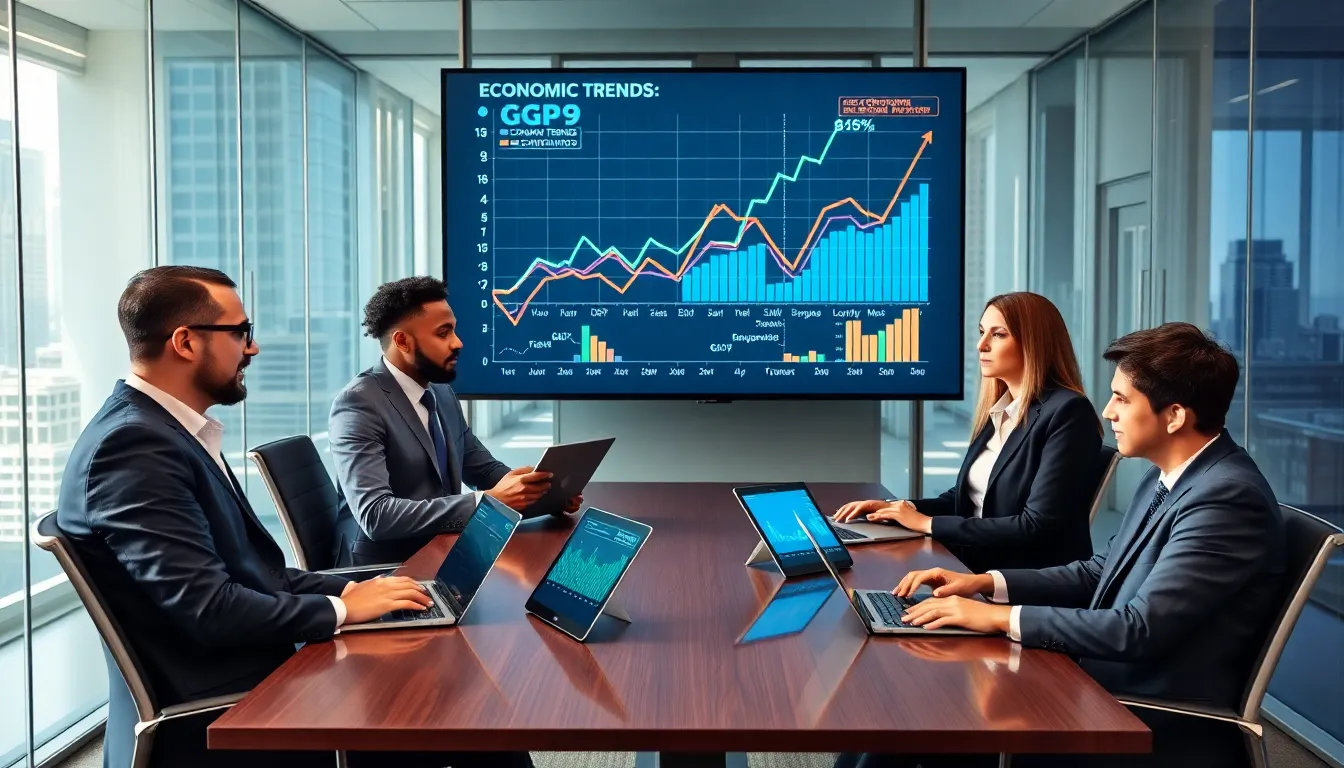Table of Contents
ToggleUnderstanding economic trends is like trying to read the tea leaves of the financial world: it’s both art and science wrapped in data-laden, dollar-driven mystery. Whether you think inflation is a quirky dance partner or labor market shifts are just the economy’s way of keeping folks on their toes, these trends shape the economy and, eventually, everyday life. Whether you are an economist, a student, or someone just trying to make sense of what’s happening around them, exploring these trends will help you navigate financial waters, even if occasional waves try to flip your boat. Grab your metaphorical life vest: we’re diving into the fascinating waters of economic trends.
Understanding Economic Trends

Economic trends are patterns or directions in economic activities that manifest over time. They provide insights into how the economy functions and are typically identified through various economic indicators such as GDP growth, employment rates, and inflation levels. Recognizing these trends early can give businesses, investors, and policymakers a competitive edge: after all, no one wants to be the last to hop on the bandwagon, especially when it’s rolling toward economic opportunity.
These trends can be cyclical, seasonal, or long-term. For instance, cyclical trends coincide with the business cycle, while seasonal trends repeat throughout the year. Long-term trends encompass shifts seen over decades, influenced by sociopolitical changes, technological advancements, and fluctuating consumer behavior. Understanding these underlying mechanics helps elucidate what’s currently happening in the economy, even if the details seem murky in the early stages.
Types of Economic Trends
Various types of economic trends exist, each serving distinct purposes and providing different insights about the economic landscape. Here are a few key categories:
1. Cyclical Trends
Cyclical trends reflect the ups and downs of the economic cycle, usually lasting from several months to several years. They involve periods of economic expansion followed by contraction and can be influenced by consumer demand, investment levels, and external shocks.
2. Seasonal Trends
Seasonal trends occur due to predictable patterns throughout the year. Think about the holiday shopping season or summer tourism peaks. Businesses often tailor their strategies to align with these seasonal rhythms, optimizing sales during peak times.
3. Long-Term Trends
Long-term trends develop over years and often signal critical changes in society. The rise of e-commerce over the past couple of decades illustrates a significant long-term shift in consumer behavior. This category can include demographic changes, major technological shifts, and evolving attitudes toward consumerism.
4. Leading and Lagging Indicators
Leading indicators precede economic changes and can help predict future movements. For example, stock market performance often serves as a leading indicator of economic sentiment. Conversely, lagging indicators confirm trends, such as unemployment rates, which often reflect the state of the economy after changes have occurred.
Historical Economic Trends in the U.S
History offers rich examples of economic trends that have significantly impacted the United States. Some notable ones include:
The Great Depression
In the 1930s, the U.S. faced a massive economic downturn, setting the stage for economic policy reformation and social safety nets. It highlighted the need for better regulation of financial markets and increased government intervention in economic affairs.
Post-War Boom
Following World War II, the U.S. economy experienced an unparalleled expansion due to factors such as technological advances, increased consumer spending, and rising employment. This era set the groundwork for today’s middle-class economy, emphasizing the importance of stability and growth.
Dot-Com Boom
The late 1990s brought the rise of the internet and tech startups, causing stock market surges and youthful entrepreneurial spirit to flourish. Even though its eventual crash, the dot-com boom paved the way for today’s tech-driven economy and changing perceptions of potential market opportunities.
2008 Financial Crisis
This crisis led to a recession that shook global markets and prompted widespread banking reforms. The event underscored both the risks and interconnectedness of the global financial system, with repercussions that are still felt today.
Current Economic Trends to Watch
Keeping an eye on current economic trends is crucial for well-informed choice-making. Several key trends shape today’s economy:
1. Inflationary Pressures
Over recent years, inflation rates have surged due to various global factors, including supply chain disruptions and increased consumer demand post-pandemic. This trend challenges purchasing power and affects businesses and households alike.
2. Remote Work Surge
The pandemic accelerated the shift towards remote work. This trend is reshaping work-from-home policies, impacting real estate markets, and altering urban development as more people opt for suburban life.
3. Sustainability Movement
A significant shift toward sustainable practices is evident across industries, driven by consumer demand and policy changes. This trend reflects growing awareness of environmental impact and the push for renewable energy sources.
Impact of Economic Trends on Industries
Economic trends can significantly influence various sectors differently. Understanding how each industry reacts to specific trends can be crucial for investors and industry players alike:
Retail
The shift toward e-commerce and the rise of mobile shopping have reshaped retail strategies. Brands now emphasize online presence and customer experience to meet evolving consumer needs.
Finance
Interest rates, inflation, and regulatory changes can drastically influence the finance sector. Financial institutions must adapt to stay resilient amidst market volatility, often implementing new technologies to serve clients better.
Technology
The technology sector thrives on innovation and disruption. Understanding technology adoption rates can provide insights into the future trajectory of industries as businesses leverage digital transformation and automation.
Future Predictions of Economic Trends
While the future is undoubtedly uncertain, various predictions based on current and historical data can provide some clues about economic trends:
Continued Digital Transformation
With companies investing heavily in technology, the trend towards digital transformation is set to continue. Expect to see advancements in automation and artificial intelligence, greatly influencing productivity and workforce dynamics.
Focus on Inclusivity
Socio-economic changes will likely drive businesses to adopt more inclusive practices, fostering diversity and equal opportunities for underrepresented groups. This shift can impact marketing strategies and workplace culture significantly.
Green Economy Growth
As the demand for sustainability increases, a transition towards a greener economy will shape industries moving forward. Investments in renewable energy and green technologies will likely drive job creation and economic growth.








